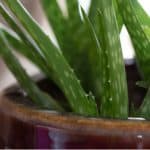Last updated on March 16th, 2022
Our site is reader supported, this means we may earn a small commission from Amazon and other affiliates when you buy through links on our site.
Poinsettias also are known as Euphorbia pulcherrima are the quintessential Christmas plant, prized for the vibrant red flowers complimented by hunter green leaves. Most people keep them around the holidays and then dispose of them once the colour fades, but you can actually grow them indoors or outdoors and keep up the beauty all year round. With a little care and attention you can even get those stunning red leaves back or whatever colour they were when you purchased it.
General Care
Don’t get caught out when you are bringing it home by exposing it to the cold
These plants need bright light, but filtered light, not strong and direct sun. They also need temperatures between 13°C and 15°C, which is around 55-59°F. That being said, if you are purchasing in the cold weather from a nursery, wrap the plant in plastic or paper bags before bringing it home, because exposure to the outdoor temperatures can damage the foliage, even in as short a time as you transport it home.
This is even more essential when purchasing one from a supermarket at Christmas time because you don’t usually know anything about the plants and they may have already been exposed to the cold before you buy it, and when this has happened there is usually nothing you can do. With this, in mind, we would recommend buying one from a reputable garden centre or nursery. Once home, you can plant it in a pot indoors and place it somewhere the temperature and sun exposure is ideal, which means filtered light and a constant warm temperature.
Improving the Colour Again
Turning Poinsettias from green to red again
Sometimes the colour is a disappointment in the second year, but there are ways you can help restore the colour again in time for Christmas.
Start by pruning the plant hard in April. Prune it to 10-20cm and then keep it stored somewhere with temperatures of around 13°C (59°F).
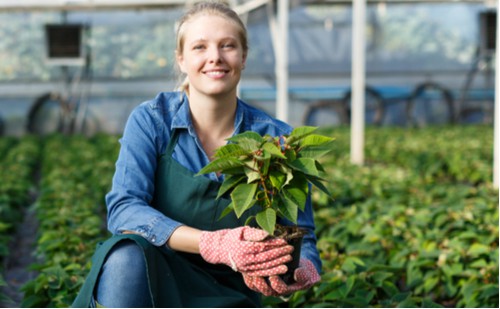
At the beginning of May, repot the plant if needed and place it somewhere cool and light for the summer, with temperatures around 15°C or 18°C. Most central heated living rooms are about the right temperature and the next step is the most important step.
In November, place the plant somewhere dark after exposing it to 12 hours of daylight, and avoid any artificial light, for most people this will mean moving it to a dark room you don’t use later in the day or placing a cardboard box over it to block out the light. This will help the colour that is instigated by the shorter day length of winter in December and January. The plant will need a consistent temperature of 18°C, so do not place it anywhere that it might get too cold.
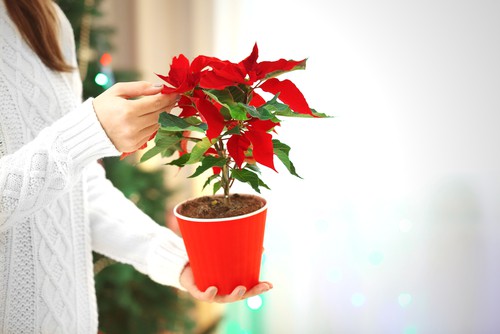
We have a detailed guide on changing the colour of Poinsettias and you can read our guide here.
Feeding and Watering
Overwatering can cause damage to the plant so it is best only to water when you notice the surface has dried out. Humidity helps to extend flowering times so you can regularly mist the flowers when in bloom, but try to avoid the leaves because this can cause leaf spot.
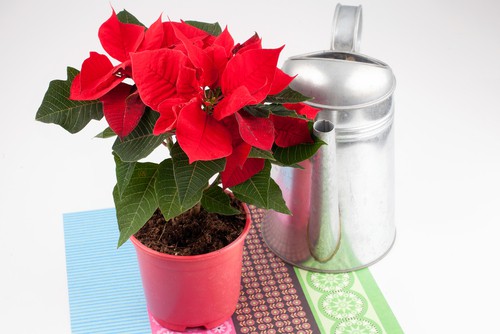
In terms of food, high potassium and low nitrogen fertilisers can be applied monthly during the summer until flowering.
Propagation by Cuttings
Poinsettias can be propagated by taking softwood cuttings. If you are going to propagate using cuttings you need to wear gloves because the milky sap is an irritant and the plant itself is somewhat toxic if ingested, although it’s not as toxic as the Euphorbias that you might have in your garden.
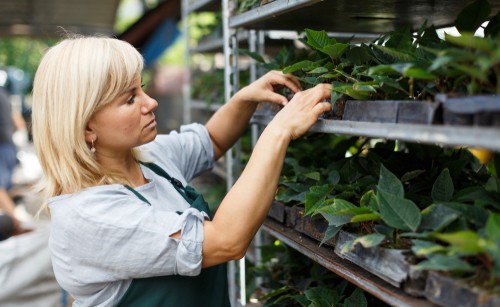
You should take the cuttings in the month of May and when you do so, use a pair of sterile, sharp cutting shears to clip pliable softwood cuttings that are no longer than 20cm in length.
With cuttings in hand prepare the potting mixture, either in small containers or propagation trays. Stick the end of the cutting in the container and cover with plastic (either a lid, bag, or cup) so that you create a small greenhouse of sorts. Keep the soil misted, so that it is moist but not overly wet or this will harbour mould. Once the root system establishes itself you can either grow them on in the pot or transplant them into their own pots if you grew them in pots.
Pests and Diseases
Poinsettias, when overwatered, can suffer from grey mould so only water once the soil is dry to avoid this. If you start to notice mould spots on your plants then reduce the amount you are watering.
There are common pests that attack Poinsettias, especially when grown indoors, and these include scale insects and mealybugs. You can control these by using a pesticide sold specially for houseplants.


